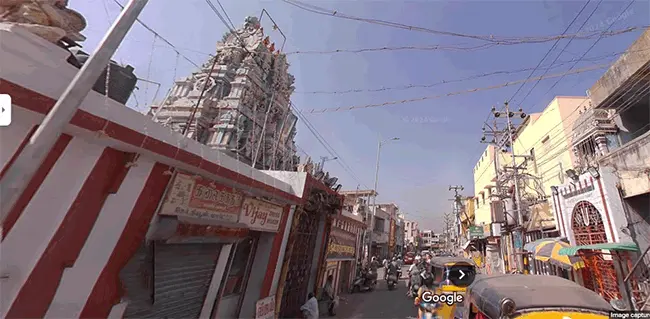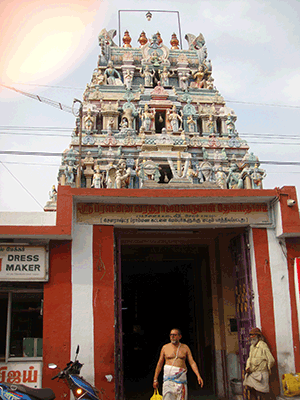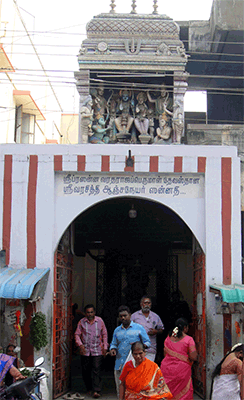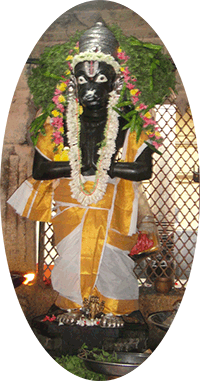
Salem
 Salem city on the bank of the river Tirumanimuthuaru is surrounded by an amphitheater of hills - the Nagarmalai in the north, the Jeragamalai in the south, the Kanjanamalai in the west, and the Godumalai in the east. The name 'Salem' appears to have been derived from the word sashaila [सशैल] which means mountainous place.
Salem city on the bank of the river Tirumanimuthuaru is surrounded by an amphitheater of hills - the Nagarmalai in the north, the Jeragamalai in the south, the Kanjanamalai in the west, and the Godumalai in the east. The name 'Salem' appears to have been derived from the word sashaila [सशैल] which means mountainous place.
Salem Fort area
Salem has been ruled by various powers, including the Hoysalas, renowned for their contributions to art, architecture, and religion. During the Hoysala and Vijayanagar periods, many temples were constructed in Salem, which was then a fortified city. Consequently, this fortified area is considered the oldest in Salem and is now referred to as the ‘Fort Area.’ Numerous ancient temples and religious institutions are located in this region, with many bearing the prefix ‘Kottai’ in their names, signifying their location in the Fort Area.
Among the notable temples are Kottai Mariamman Temple, Alagirinathar Temple (also known as ‘Kottai Perumal Koil’), and Sri Suguvaneshwara Temple, located in Mettu Agraharam, commonly referred to as ‘Kottai Eswaran Kovil.’
Agraharams
Agraharams are defined as ‘endowments of land conferred upon Brahmaṇas or lands offered as gifts to Brahmaṇas for their sustenance,’ according to Sanskrit dictionaries. Today, names such as First Agraharam, Second Agraharam, and Mettu Agraharam adorn the Kottai area of Salem. This indicates that the area once thrived with religious activity and was vibrant with social and cultural interests. Numerous vigrahas of deities have been unearthed in this area, leading to the belief that it has suffered significant harm and damage over time. There are a few mutts of Sanatana Dharma that have survived these calamities.
Second Agraharam
 This area remains the most populous and bustling part of the city. About two hundred years ago, members of the Tamil Saurashtrian community sought to build a temple on land in Second Agraharam. On an auspicious day, excavation began at the designated site, and a full stone vigraha of Sri Lakshmi Narasimha Swamy was unearthed, viewed as a good omen.
This area remains the most populous and bustling part of the city. About two hundred years ago, members of the Tamil Saurashtrian community sought to build a temple on land in Second Agraharam. On an auspicious day, excavation began at the designated site, and a full stone vigraha of Sri Lakshmi Narasimha Swamy was unearthed, viewed as a good omen.
This event confirms that the Kottai area thrived with religious activity in the past.
Tamil Saurashtrian community sought to build a temple on land in Second Agraharam. On an auspicious day, excavation began at the designated site, and a full stone vigraha of Sri Lakshmi Narasimha Swamy was unearthed, viewed as a good omen.
Sri Varadharaja Perumal Temple
As planned, the Tamil Saurashtrian community constructed a temple for Sri Varadharaja Perumal in this location. Today, devotees can see the Sri Lakshmi Narasimha vigraha, unearthed during the temple's foundation, being worshipped there. The Sri Varadharaja Perumal Temple of Second Agraharam is popularly known as ‘Pattai Kovil.’ The main deity of the temple is Sri Prasanna Varadharaja Perumal.
Sri Prassana Anjaneya Temple
Opposite the Sri Prassana Varadharaja temple right across the road is the temple for Sri Anjaneya facing the main deity Sri Prassana Varadharaja. The arch above the entrance is adorned with a stucco figure depicting the scene of Sri Rama Pattabhishekam. Lord Sri Anjaneya is present in the huge tall stone mandapam in the center, which constitutes the sannidhi – Temple of Sri Anjaneya. There is a pathway all around the mandapam for the devotees to circumambulate [pradhakshinam]
Adjacent to Sri Anjaneya temple is Vasantha mandapam.
Sri Prassana Anjaneya
 The idol of the Lord is made of black hard stone and is about five feet height in standing posture. Lord is seen mounted on a lotus platform of about two feet.
The idol of the Lord is made of black hard stone and is about five feet height in standing posture. Lord is seen mounted on a lotus platform of about two feet.
In the lotus feet of Lord is seen with a hollow anklet [thandai] and a chain anklet [nupur]. He is wearing a dhoti in kacham style and held in the waist with a decorative waist belt [udarabandha]. On the upper hand a bracelet known as ‘keyur’ and on the wrist a bracelet known as ‘Kangan’ are seen. His folded hands are seen with palms joined, offering ‘pranam’ to His Lord. In the bosom, a long mala [rosary beads] and yagyopavit are seen. There is an ornament close to His neck. The kundal He is wearing in the ears is seen touching His shoulders. Lord’s tail is seen raised to the head and ending to the left side with a small bell at the end. Neatly tied kesam is held by the ‘kesa bhadna’. A small portion of His kesam is gently flowing on the sides. Lord is looking straight with His bright eyes and the kataksham of the Lord falls directly on the devotee.
Location of the temple: "Sri Prassana Anjaneya Temple, Pattai kovil, Salem"
Experience
The Lord of this kshetra is seen looking at His Lord Sri Varadharaja, the giver of boons. Offering prayer to the Lord of this kshetra is bound to bestow the righteous boons of His devotees.
SRI HANUMAN THINKS DIFFERENTLY, THINKS FAST
THINKS AHEAD AND ACTS FOR SURE
Ed [December 2024]
